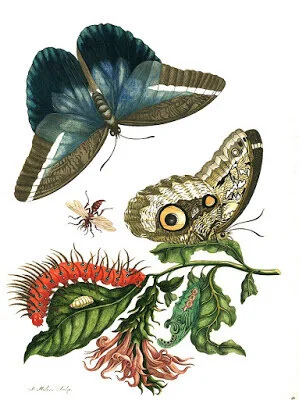To all lovers and investigators of nature
Seven wild women / Maria Sibylla Merian
After waking from a night of unsettling dreams, Gregor Samsa became increasingly aware that something was amiss, ‘lying on his back as hard as armour plate’, he peers down at his ‘vaulted brown belly, sectioned by arch-shaped ribs’, his pitifully thin legs ‘waving helplessly before his eyes’. Overnight he had changed, an impossible sickening transformation had taken place, all recognisable signs of elastic fleshy human form had been replaced by toffee hard segmented limbs that clicked and crackled with clockwork toy exactitude, his torso, no longer soft and flexible, now fused stiff within a clumsy shellac casket, a terrifying realisation shuddered through Gregor, he had become a huge bug, a ‘monstrous vermin’.
There are many theories concerning the plight of Mr Samsa and the exact meaning behind the demons that Franz Kafka was exorcising in his 1915 classic The metamorphosis. In this dark and disturbing yarn he explores the irreversible truths of time and transformation and the alien horrors of mutation, as well as tinkering just a tiny bit with a lot of peoples general fear of bugs, let's be honest here, the story would have been very different had Gregor woken up as a kitten.
Metamorphosis is a natural phenomena that has forever intrigued and fascinated scientists, storytellers and artists, no matter how acquainted with its mechanisms you become, the concept will always bend your mind to a snapping point. Maria Sibylla Merian was no exception, she was obsessed with metamorphosis, her meticulous scientific studies of insects along with her vivid artworks are considered exceptional even to this day.
Born in Frankfurt in 1647 into Swiss heritage, Maria was encouraged to paint from an early age by her stepfather Jacob Marrel, a renowned and respected painter who specialised in still life and importantly for Maria, the painting of flowers. Frankfurt at this period in time was known the world over for its silk trade, Maria managed to get her hands on a few silkworms and by the age of thirteen was rearing them, tending them daily through to their cocoon stage and eventual emergence as a moth. These intimate early silkworm days sparked Marias creative and scientific mind, the seed had been sown leading to broader interest in insects blossoming.
““I spent my time investigating insects. At the beginning, I started with silk worms in my home town of Frankfurt. I realised that other caterpillars produced beautiful butterflies or moths, and that silkworms did the same. This led me to collect all the caterpillars I could find in order to see how they changed.””
Marias first book New book of flowers was published in 1675 followed two years later by volume one of her two part opus The marvellous caterpillar, marvellous transformation and strange floral food. This work broke new ground, fifty plates (illustrations), all etched and engraved by Maria, exquisitely detailed pages depicting insects, plants, caterpillars and butterflies, covering 186 European insect species, along with their host plant and life cycle were described in these pages, both description and illustration equally lucid and captivating, the second volume followed in 1687.
Marias married life was not a happy one and after leaving her husband took up home in a property owned by the governor of Surinam, this gave her the opportunity to travel to Surinam on the northern coast of South America, here she submerged herself in the study of tropical insects. The resulting Metamorphosis insectorum Surinamensium was published in 1705 at her own expense, the breathtaking illustrations lovingly coloured by herself and her daughters, each painting its own picture of the dedicated and humble soul of the artist, it simply reads ‘to all lovers and investigators of nature’. Through her studies she contributed many new discoveries and forwarded many brave and groundbreaking ideas, Maria’s fearless and energetic love of the natural world and avid attention to detail will continue to astound and inspire both artists and scientists today and well into the future.



